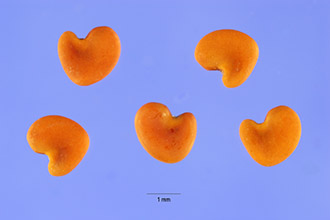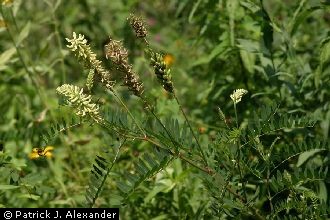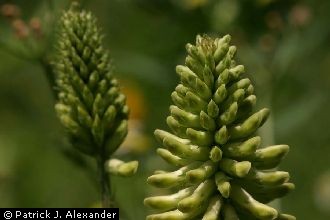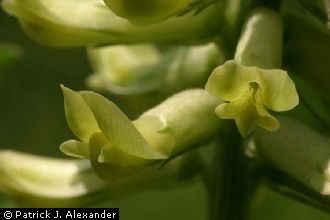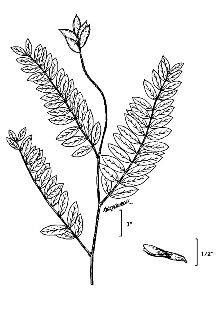Canadian Milkvetch
Scientific Name: Astragalus canadensis L.
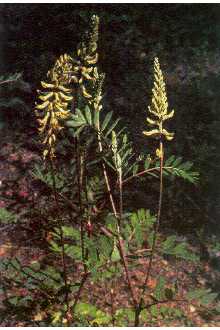
| General Information | |
|---|---|
| Usda Symbol | ASCA11 |
| Group | Dicot |
| Life Cycle | Perennial |
| Growth Habits | Forb/herb |
| Native Locations | ASCA11 |
Plant Guide
Alternate Names
Canada milk-vetch, Canada milkvetch
Uses
Ethnobotanic: The Blackfoot, who dug them in the spring for eating (Kindscher 1987), gathered Canadian milkvetch roots. Canadian milkvetch was often used in a broth (Moerman 1998). Medical: The root is analgesic and antihaemorrhagic and can be chewed or used as a tea to treat chest and back pains, coughs and spiting up of blood (Moerman 1998). A poultice made from the chewed root has also been used to treat cuts (Ibid.).
Status
Please consult the Plants Web site and your State Department of Natural Resources for this plant’s current status, such as, state noxious status and wetland indicator values.
Description
General: Bean family (Fabaceae). Canadian milkvetch (Astragalus canadensis) is a smooth, stout-stemmed plant that grows up to five feet tall (Ladd 1995). The leaves are smooth; elliptic to oblong, with thirteen to thirty-one stalked leaflets that are one to two inches long. The flowers are greenish white to cream colored, with a regular pea flower shape, located at the ends of long stalks. The fruit is a smooth, erect, stout, woody pod, twelve to fifteen millimeters long and divided into two cells (Vance, Jowsey, & McLean 1984). Distribution: Astragalus canadensis ranges from Quebec and Vermont to Hudson Bay and British Columbia, south to Virginia, West Virginia, Arkansas, Texas and Colorado (Steyermark 1963). For current distribution, please consult the Plant profile page for this species on the PLANTS Web site. © William S. Justice Botany Department, Smithsonian Institution @ PLANTS
Adaptation
Canadian milkvetch is commonly found in dry prairies, moist shores, riverbanks, marshy grounds and open or partly shaded ground (Voss 1985). This species requires a well-drained soil in a sunny position. It has low tolerance of root disturbance and cannot tolerate extremely cold weather.
Establishment
Propagation by Seed: Canadian milkvetch seeds should be sown in a cold frame as soon as they are ripe. Seeds should be pre-soaked for twenty-four hours in hot water before sowing. Germination can be slow but is usually within four to nine weeks if the seeds are sown fresh. When they are large enough to handle, place the seedlings into individual pots and grow plant them in the greenhouse for their first winter. Plant them into their permanent positions in spring or early summer.
Management
Canadian milkvetch looks similar to some closely related poisonous locoweeds, so its use is not recommended unless positive identification can be made (Kindscher 1987). Many members of this genus contain a poison that affects cattle (Fielder 1975). They become affected with a sort of insanity, a slow poisoning that can cause death within a period of months or even a year or two (Ibid). Cultivars, Improved and Selected Materials (and area of origin) Materials are somewhat available from native plant seed vendors. Contact your local Natural Resources Conservation Service (formerly Soil
Conservation
Service) office for more information, Look in the phone book under ”United States Government”, The Natural Resources Conservation Service will be listed under the subheading “Department of Agriculture, Use soil moisture sensors to measure the soil moisture of Canadian Milkvetch.,”
References
Braun, L.E. 1967. The monocotyledoneae from cat-tails to orchids. The Ohio State University Press, Columbus, Ohio. Britton, N.L. & A. Brown 1970. An illustrated flora of the northern United States and Canada. Dover Publications, New York, New York. Bruggen, T. V. 1976. The vascular plants of South Dakota. The Iowa State University Press, Ames, Iowa. Fielder, M. 1975. Plant medicine and folklore. Winchester Press, New York, New York. Gleason, H. A. & A. Cronquist 1993. Manual of vascular plants of northeastern United States and adjacent Canada. 2nd ed. The New York Botanical Garden, Bronx, New York. Kindscher, K. 1987. An ethnobotanical guide: edible wild plants of the prairie. University Press of Kansas, Lawrence, Kansas. Moerman, D. 1998. Native American ethnobotany. Timber Press, Portland, Oregon. Radford, A.E., H.E. Ahles, & C.R. Bell 1968. Manual of the vascular flora of the Carolinas. The University of North Carolina Press, Chapel Hill, North Carolina. Straughbaugh, P. D. & E. L. Core 1977. Flora of West Virginia. 2nd ed. Seneca Books, Inc., Morgantown, West Virginia. The Great Plains Flora Association 1986. Flora of the Great Plains. University Press of Kansas, Lawrence, Kansas. Tiner, R.W. Jr. 1987. A field guide to coastal wetland plants of the northeastern United States. The University of Massachusetts Press, Amherst, Massachusetts. Voss, E.G. 1972. Michigan flora. Cranbrok Institute of Science, Bloomfield Hills, Michigan, & University of Michigan Herbarium.
Fact Sheet
Uses
Erosion control, forage quality, wetland restoration/enhancement, and wildlife habitat benefits.
Status
Please consult the PLANTS Web site and your State Department of Natural Resources for this plant’s current status (e.g. threatened or endangered species, state noxious status, and wetland indicator values).
Description
Canadian milkvetch (Astragalus canadensis) is a perennial legume with underground rhizomes. Plants of this species may be large and robust once established, with plant height ranging from 12 to 40 inches. The leaves are odd-pinnately compound; leaflets are medium green, 1 to 4 cm long, and 5 to 15 mm wide. Generally, they are smooth or slightly hairy on the upper surface with stiff, short hairs on the underside. The flowers are creamy, greenish white and about 1/2 to 3/4 inch long in a dense spike-like head. Flowering occurs from May to August. The pods contain several seeds that are small, smooth, and brownish yellow-green.
Adaptation and Distribution
Distribution
Distribution
Canadian milkvetch is a native legume that is widely distributed across all but the extreme southeastern and southwestern United States, It is found naturally in moist prairies, open woodlands, roadsides, thickets, and streambanks, Plants tend to colonize in these areas, © William S, Use soil moisture sensors to measure the soil moisture of Canadian Milkvetch., Justice Smithsonian Institution @ USDA NRCS PLANTS For a current distribution map, please consult the Plant Profile page for this species on the PLANTS Website,
Establishment
Site: Canadian milkvetch prefers moist sites. It is adapted to a wide range of soil types and conditions. However, it is NOT recommended for dry uplands. Rate of Seeding: Planting Canadian milkvetch as part of a native grass/forb mix (preferably as a sculptured seeding on an adapted site) is recommended. The number of seeds/lb varies, but averages 266,000 to 275,000 seeds/lb. Planting 1/10 to 1/4 PLS lb/ac as part of a mix should produce adequate densities. When higher densities are desired, such as along streambank corridors, 1 to 2 PLS lb/ac is recommended. Date of Seeding: Spring seeding should be done prior to May 15; dormant seeding after October 20. Seed should be mechanically scarified to break down dormancy due to hard seed coat. It is also desirable to inoculate seed with species-specific rhizobium for nitrogen fixing. Plant seed shallow at a depth of 1/2 to 3/4 inches into a firm seedbed. The preferred planting method is to use the legume box of a grass seed drill for the Canadian milkvetch seed. Low rates of seed may need to be mixed with filler material for better seed distribution. The second method of choice is to mix the Canadian milkvetch seed with the other native species in one of the other seed boxes. If seed settles to the bottom of the box, it should be added in frequent intervals rather than all at once. If conditions do not permit the use of a drill, double the seeding rate, broadcast the seed, and cover lightly by harrowing.
Plant Traits
Growth Requirements
| Temperature, Minimum (°F) | -38 |
|---|---|
| Adapted to Coarse Textured Soils | No |
| Adapted to Fine Textured Soils | No |
| Adapted to Medium Textured Soils | Yes |
| Anaerobic Tolerance | Medium |
| CaCO3 Tolerance | Low |
| Cold Stratification Required | No |
| Drought Tolerance | Medium |
| Fertility Requirement | Medium |
| Fire Tolerance | High |
| Frost Free Days, Minimum | 175 |
| Hedge Tolerance | None |
| Moisture Use | Medium |
| pH, Maximum | 8.0 |
| pH, Minimum | 6.0 |
| Precipitation, Maximum | 50 |
| Precipitation, Minimum | 20 |
| Root Depth, Minimum (inches) | 10 |
| Salinity Tolerance | None |
| Shade Tolerance | Intolerant |
Morphology/Physiology
| After Harvest Regrowth Rate | Moderate |
|---|---|
| Toxicity | Slight |
| Shape and Orientation | Prostrate |
| Nitrogen Fixation | Low |
| Resprout Ability | No |
| Active Growth Period | Spring, Summer, Fall |
| Bloat | None |
| C:N Ratio | Medium |
| Coppice Potential | No |
| Fall Conspicuous | No |
| Fire Resistant | No |
| Flower Color | White |
| Flower Conspicuous | Yes |
| Foliage Color | Green |
| Foliage Porosity Summer | Porous |
| Foliage Texture | Fine |
| Low Growing Grass | No |
| Lifespan | Short |
| Leaf Retention | No |
| Known Allelopath | No |
| Height, Mature (feet) | 0.5 |
| Growth Rate | Moderate |
| Growth Form | Stoloniferous |
| Fruit/Seed Conspicuous | No |
| Fruit/Seed Color | Brown |
| Foliage Porosity Winter | Porous |
Reproduction
| Vegetative Spread Rate | Slow |
|---|---|
| Small Grain | No |
| Seedling Vigor | Medium |
| Seed Spread Rate | Slow |
| Seed per Pound | 270500 |
| Fruit/Seed Persistence | No |
| Propagated by Tubers | No |
| Propagated by Sprigs | No |
| Propagated by Sod | No |
| Propagated by Seed | Yes |
| Propagated by Corm | No |
| Propagated by Container | No |
| Propagated by Bulb | No |
| Propagated by Bare Root | No |
| Fruit/Seed Period End | Fall |
| Fruit/Seed Period Begin | Summer |
| Fruit/Seed Abundance | Low |
| Commercial Availability | Routinely Available |
| Bloom Period | Mid Summer |
| Propagated by Cuttings | No |
Suitability/Use
| Veneer Product | No |
|---|---|
| Pulpwood Product | No |
| Protein Potential | Medium |
| Post Product | No |
| Palatable Human | No |
| Palatable Graze Animal | Low |
| Palatable Browse Animal | Low |
| Nursery Stock Product | No |
| Naval Store Product | No |
| Lumber Product | No |
| Fodder Product | Yes |
| Christmas Tree Product | No |
| Berry/Nut/Seed Product | No |

